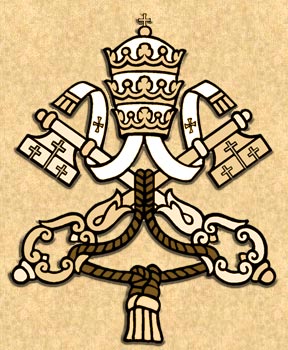This Catherine was the daughter of John de'Vigri, attorney and aide to Nicholas d'Este, Marquis of Ferrara. When Catherine was 11, the Marquis asked that she be allowed to live in his palace as maid of honor to his daughter Margaret. The two girls, about the same age, became best friends. Their tutor taught them Latin, among other subjects, and Catherine later wrote some small works in that tongue. Their companionship continued until Margaret became engaged to the nobleman Roberto Malatesta. The engaged girl wanted her to stay on as her maid in waiting. But, although Catherine herself had several suitors, she had already decided that the religious life rather than the courtly life was her calling.
At the age of 14, the de'Vigri girl asked to be admitted into a group of Ferrarese women who belonged to the third order of Franciscans, but were living a semi-monastic life. Eventually this group adopted the rule of the second order of Franciscans, and became Poor Clares. From the day of her entrance, Sister Catherine threw herself wholeheartedly into the quest for perfection. Concluding eventually that her Ferrara convent was less strict in its life than she preferred it to be, she accepted (although hesitantly) the appointment as abbess of a more austere convent of Poor Clares in Bologna. She continued to head this community from 1456 until her death.
Early in her religious life, Sister Catherine began to receive many supernatural graces. She passed on to her companions her own spiritual experiences, for their benefit. Most remarkable of the happenings that she recorded was what happened one Christmas Eve.
On this occasion, she had asked permission to spend the night of December 24-25 alone in the convent chapel. It was her intention to recite 1000 Hail Marys in honor of the nativity. At the hour of midnight, Mary herself appeared to Catherine with the swaddled Christchild in her arms. The Mother of God even handed the Infant to Sister Catherine. The nun pressed Him to her breast and kissed His cheek. When she sought to kiss His mouth, too, He disappeared, but her heart continued to experience a unique joy.
Like most true mystics, St. Catherine was also a person of talent and common sense. She was a skilled artist, and devoted much time to copying out in print her breviary, illustrating it with attractive pictures of Jesus, Mary, and the saints. She also painted larger religious pictures, composed hymns, and wrote several devotional works.
Although Catherine of Bologna was very strict with herself, she did not demand that the other sisters match her standards. There were three practical rules that she gave them: 1. Always speak well of people. 2. Practice humility constantly. 3. Never meddle in the business of others.
Though long frail in health, Sister Catherine de'Vigri died on March 9, 1463, after only a short terminal illness. She breathed her last so quietly that her sisters were unaware that she was dead until they smelt a lovely fragrance rising from her body and saw her middle-aged face restored to its teenage bloom. As a matter of fact, her body, later enshrined in the monastery chapel, has never corrupted. The flesh has grown dark, but that may well have been because of the heat and soot of the candles that were burned for years around her exposed remains. In that shrine, her body is not recumbent but seated! This was in response, it is said, to a request she made of one of her sisters to whom she appeared in a vision in 1500.
Soon after the death of Abbess Catherine, miraculous cures began to be granted to many who prayed for her intercession. She was canonized as "St. Catherine of Bologna" in 1712. Now, St. Luke is usually considered the patron saint of painters because of the portrait he is reputed to have made of the Blessed Virgin. But St. Catherine is also particularly venerated by artists. The skill of her paintings that still survive certainly qualify her for the role of a heavenly patroness of the arts.









No comments:
Post a Comment